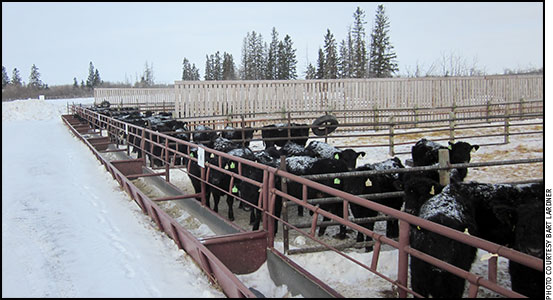MANAGEMENT...

Backgrounding Options
Researcher compares performance of weaned calves between drylot and field-grazing backgrounding systems.
After weaning, there are several programs that can be used to grow calves at a targeted rate of gain and help ensure good productivity and future performance after they enter the feedlot.
Bart Lardner, research scientist at Western Beef Development Center, University of Saskatchewan, says backgrounding aims for a controlled rate of growth, trying to maximize frame size before depositing fat.
“That way we can produce a greater carcass weight at slaughter. It’s all about muscle development and skeletal size for the best potential growth,” he says.
Every animal has a certain growth potential.
“What that ultimate growth can be is controlled by genetics, but the part we can control is environment and nutrition. Most spring-born calves are weaned at 5 to 7 months [of age], and many go into a backgrounding program, depending on the end target,” Lardner explains.
Some light calves are put on a growing ration during winter and then go to grass in the spring for several months. Read more.
Drought Affords New Perspective
The benefit of drought may be found in forced better management.
Every cattle producer looks at use of resources and application of management practices through a different lens, and each producer’s lens is filtered by experience. With that in mind, USDA Agricultural Research Service Range Scientist Justin Derner said drought may not be all bad.
Speaking during Range Beef Cow Symposium XXV, hosted Nov. 28-30 in Cheyenne, Wyo., Derner suggested experiencing drought can make a range cattle producer take a hard look at his or her operation and think about how they might do things differently — even during years of more “normal” precipitation. Drought may not be all bad if it is a catalyst for changes that are beneficial for the long term. Read more.
Breeding Season Schedule
Planned breeding schedules pay dividends for beef producers.
Financial opportunities can be found in designing strong breeding and forage/pasture plans for beef cattle herds, according to a Texas A&M AgriLife Research scientist
.
In a business where every pound counts and every expense should be optimized, Monte Rouquette, AgriLife Research forage physiologist, Overton, said producers should consider planned breeding windows for their cow herd, if possible.
Most beef cattle operations have completed fall calving and should introduce bulls by Dec. 1-15 to have calves on the ground in early fall 2018, he said. Read more.
Controlling Lice
Expert offers tips for choosing the right product to kill lice on cattle.
For long-term lice control, producers need to kill the eggs, as well as adult lice on cattle and then not re-expose those treated animals to lice.
Larry Hawkins, technical services veterinarian at Bayer, says many products just kill adult lice but don’t affect the eggs. The eggs go ahead and hatch, and three weeks later, the cattle have lice again. Label directions recommend retreatment in two to three weeks to kill young lice that hatched after the first treatment. Retreatment is necessary to kill those young lice before they mature enough to start laying eggs. Read more.

Kris Ringwall
Beef Talk
Just when does one let the calves go?
Hay is the staple for cow-calf producers.
How much hay an operation needs to feed vs. how much hay an operation feeds are two different numbers. So assuming cattle consume most of their feed needs from forage, let’s figure. A pencil, pad of paper and some notes go a long way in trying to get the answers one needs.
This is not a ration-balancing process, but a rough estimate of forage needs. While grain and other feedstuffs can be fed as a replacement for hay, the question today is to ponder forage needs. Begin by knowing the pounds of cattle to be fed. Read more.
New Products
A few product highlights from the Angus Convention Trade Show.
With 160 vendors displaying products and services at the 2017 Angus Convention Trade Show, producers had plenty to explore — from animal health and genetics companies to products related to nutrition, fencing, waterers, ear tags and much more. These products are among the highlights.
From Stafix, an electrical fencing company that is part of the Tru-Test Group, a product popular with producers is the Fault Finder Remote. The handheld device, which is compatible with Stafix energizers, quickly and easily locates shorts along the fenceline. The remote displays the current, voltage and an arrow toward the direction of a detected short. One remote can work with multiple Stafix energizer units. For more information visit www.stafix.com. Read more.
Angus Advisor
Click here for January herd management tips from cattle experts across the nation. Advice separated by region.
[Click here to go to the top of the page.]






